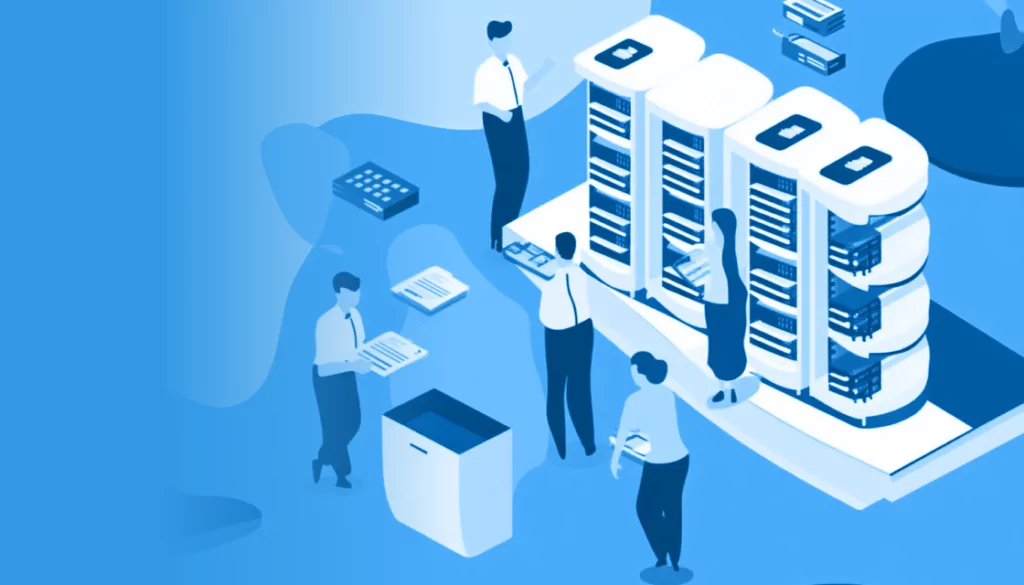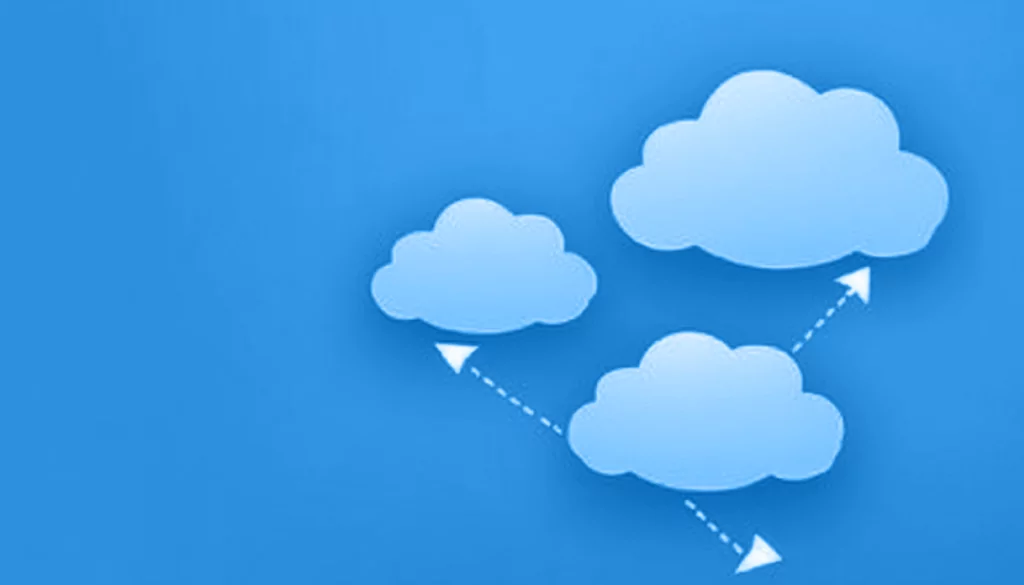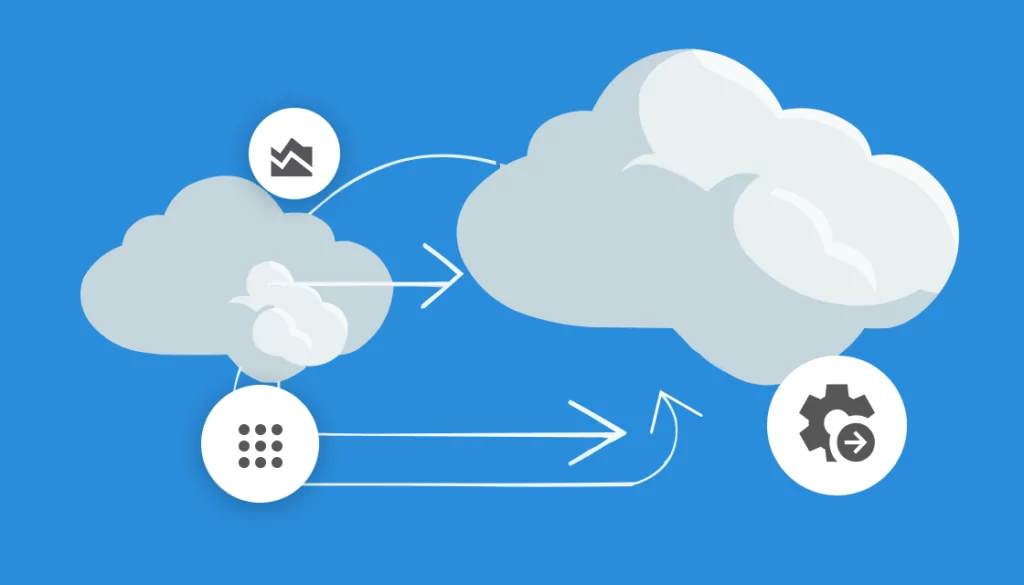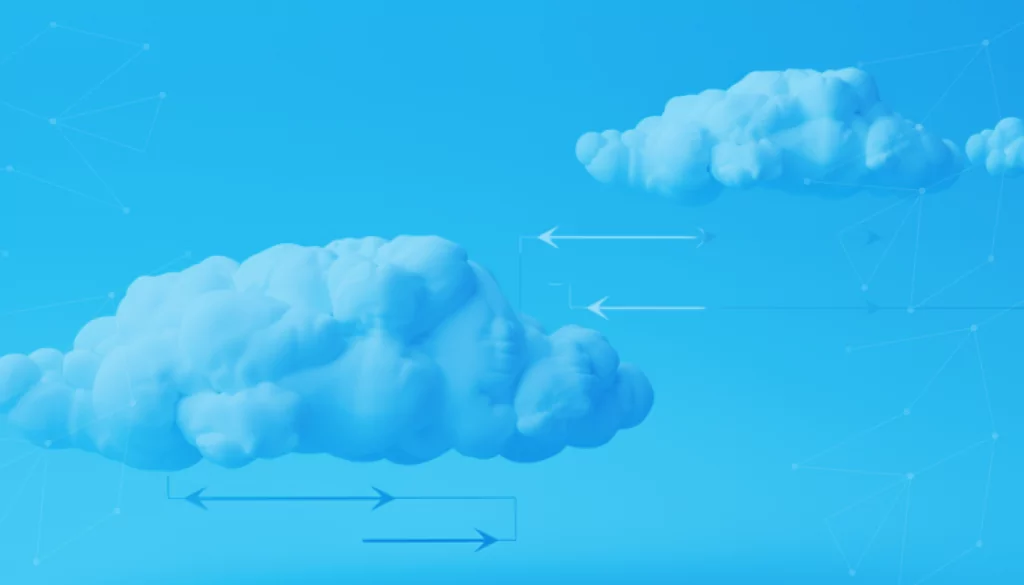Cloud migration is the act of transferring an organization’s digital assets into the cloud. Cloud migration can be focused on a specific application or environment, or might involve a complete move of all assets into the cloud.
Cloud migration presents cloud-ready businesses with tremendous upside. With benefits like cost savings and productivity gains, adopting the cloud makes for savvy businesses. But recent cloud trends also present a fair amount of challenge and risk.
Read on for a look at what cloud migration is and all you need to know about moving to the cloud. (This is part of an extensive series of guides about hybrid cloud.)
Table of Contents
Toggle- What is a Cloud Migration Strategy?
- Cloud Computing Models
- Types of Cloud Services
- Benefits of Cloud Migration
- Tips from the Expert
- Types of Cloud Migration Strategies
- Challenges of Cloud Migration
- Cloud Migration Risks
- Key Cloud Migration Steps
- Streamline your Cloud Migration with Faddom
- Learn More About Cloud Migration
- See Additional Guides on Key Hybrid Cloud Topics
What is a Cloud Migration Strategy?
A cloud migration strategy is a plan to transition its data and applications into the cloud. While the cloud offers many benefits, not all applications and services are able to realize the advantages of running on cloud-based infrastructure. A cloud migration strategy helps identify which assets can function in the cloud, potential challenges, risks, and the value an organization stands to gain. It also includes a systematic cloud migration checklist for complete the transition.
Cloud Computing Models
Cloud computing networks exist in three forms. These include:
Public Cloud
A public cloud is owned and managed by a cloud provider and billed for on a pay-per-use basis. Public clouds are ideal for small and medium-sized businesses that want an easy-to-manage ecosystem that’s easily scalable. Most public cloud solutions are also affordable, making them attractive to small and medium businesses. While easily accessible and affordable, public clouds are also considered less secure for sensitive data.
Examples of public clouds include Microsoft Azure and Google Cloud.
Private Cloud
A private cloud is a custom-designed cloud infrastructure that’s owned and controlled by a business or a third-party provider. This type of cloud is ideal for large organizations that need greater control over their data and security, and any unique development requirements can be quickly executed. It is more expensive as more assets are hosted in data centers not owned by the organization.
Hybrid Cloud
A hybrid cloud is a combination of private and public cloud models. It’s ideal for businesses interested in flexibility, security, and scalability, with lower operational costs. One of the most common concerns related to hybrid clouds is the transfer of data from private to public clouds and that it can cause network communication conflicts.
Types of Cloud Services
Cloud services are solutions that make it possible for businesses to run applications and other business-critical resources in the cloud. There are three types of cloud services:
IaaS (Infrastructure as Service)
IaaS is the most common cloud service and includes virtual servers, operating systems, networks, and data storage drives. Using IaaS relieves businesses from the CAPEX costs of investing in hardware and software and the cost of running and maintaining both on-premise. IaaS can be rented and is constantly maintained by a cloud provider. This makes it a smart option for cloud-ready businesses.
PaaS (Platform-as-a-Service)
PaaS includes an infrastructure and software framework that businesses use to develop and run, and manage their own applications. PaaS makes it easier to roll out and scale your web application and its usage.
SaaS (Software as a Service)
SaaS solutions are software-based products and services that are used in the cloud. These are easy to deploy and paid for on a per-use basis and a recurring billing cycle (typically monthly). SaaS solutions are also maintained by the product provider, freeing businesses from the need to spend more on in-house support for unique applications.
Benefits of Cloud Migration
Here are key benefits of cloud migration:
Optimized Performance
Cloud platforms enable businesses to scale resources up or down according to their needs, which helps optimize performance. Companies can easily allocate more computing power, storage, or bandwidth when required, and scale back when demand decreases. This flexibility allows businesses to maintain high-performance levels while avoiding wasted resources.
Manage End-of-Life Cycles
In an on-premise environment, hardware and software inevitably reach their end-of-life, requiring replacement or upgrades. This can be time-consuming and costly. In a cloud-based environment, the service provider takes responsibility for maintaining and updating the infrastructure, ensuring that hardware and software components are always up to date. This helps businesses avoid the hassles and costs associated with managing end-of-life cycles for their on-premise infrastructure.
Lower Costs
Cloud migration can result in significant cost savings for businesses. By leveraging the cloud, companies can eliminate the need for purchasing and maintaining on-premise hardware and software, as well as the costs associated with powering and cooling these systems.
The pay-as-you-go pricing model of cloud services allows businesses to only pay for the resources they actually use, reducing overall costs. Additionally, the ability to scale resources on-demand helps businesses avoid over-provisioning and under-utilization, leading to more efficient use of resources and cost savings.
When embarking on a cloud to cloud migration, it’s crucial to choose the right cloud migration tools that can simplify the process and ensure minimal disruption to your operations. Whether you’re considering cloud migration to AWS for its scalability and extensive services, cloud migration to Azure for its seamless integration with Microsoft products, or even a Google cloud migration for advanced data analytics and machine learning capabilities, the key to success lies in selecting the cloud platform that aligns with your specific business needs.
Additionally, some businesses may opt for cloud repatriation, which involves moving workloads back to on-premises environments or private clouds when cloud solutions no longer meet their needs. The key to a successful migration or repatriation is aligning the strategy with your long-term goals.

Lanir specializes in founding new tech companies for Enterprise Software: Assemble and nurture a great team, Early stage funding to growth late stage, One design partner to hundreds of enterprise customers, MVP to Enterprise grade product, Low level kernel engineering to AI/ML and BigData, One advisory board to a long list of shareholders and board members of the worlds largest VCs
Tips from the Expert
In my experience, here are tips that can help you manage cloud migrations effectively:
-
Define the right migration strategy
Evaluate whether rehosting, replatforming, or refactoring suits your applications based on cost, complexity, and goals.
-
Conduct a detailed pre-migration assessment
Identify dependencies, compatibility issues, and potential risks to create a solid migration plan.
-
Implement robust security measures
Apply encryption, access controls, and continuous monitoring to protect data and ensure compliance.
-
Utilize automation tools
Automate repetitive tasks like data transfer and application configuration to reduce errors and save time.
-
Prepare for post-migration optimization
Continuously monitor and fine-tune applications for performance and cost efficiency using cloud-native tools.
Types of Cloud Migration Strategies
Rehosting (Lift and Shift)
Rehosting, also known as “lift and shift,” is the process of moving an application and its associated data from an on-premise environment to the cloud without making significant changes. The application’s architecture remains largely unchanged, and the primary focus is on migrating the infrastructure components. This approach is often faster and more cost-effective than other migration strategies but may not fully leverage the benefits of cloud-native features.
Replatforming
Replatforming involves making minimal changes to the application’s architecture while taking advantage of some cloud-native features. This approach may include migrating an application to a managed Platform as a Service (PaaS) or containerizing the application to run on container orchestration platforms like Kubernetes. Replatforming can improve application scalability, performance, and manageability, while still avoiding the complexities of a complete refactor.
Repurchasing
Repurchasing, sometimes referred to as “drop and shop,” involves moving from a legacy system or application to a new cloud-based solution. This strategy often includes replacing on-premise software with Software as a Service (SaaS) offerings. While this approach may require significant changes to business processes and integration with existing systems, it can lead to cost savings, enhanced features, and reduced maintenance burdens.
Refactoring
Refactoring, or re-architecting, is the process of redeveloping an application from the ground up to take full advantage of cloud-native capabilities, such as microservices architecture, serverless computing, or elastic scaling.
This approach can be time-consuming and resource-intensive but can result in significant performance improvements, cost savings, and increased agility. Refactoring is often chosen when the existing application is not meeting new business needs or as a way to fully embrace the cloud’s potential.
Retiring
Retiring involves identifying and decommissioning applications or systems that are no longer needed or can be consolidated with other existing solutions. This process helps businesses reduce costs and complexity by eliminating redundant or outdated applications. Retiring is an essential step in the migration process, as it helps organizations focus their resources on applications that deliver value.
Retaining
Retaining, or re-assessing, is the strategy of keeping certain applications or systems in their current environment. This decision may be based on factors such as regulatory requirements, the cost of migration, or the strategic importance of the application. In some cases, retaining an application may be a temporary decision, with plans to revisit the migration at a later time when it is more feasible.
Challenges of Cloud Migration
Cloud migration and data center migration are complex undertakings. Common challenges business experience include:
Managing Legacy Applications
The cloud can house almost any application, however, not every application should be in the cloud. Most can’t be easily moved to the cloud without causing serious disruption to business operation and some cannot function effectively within the cloud without additional development, or worse yet, a complete rebuild.
Application Modernization
Choosing whether to end-of-life or kill on-premise applications and rebuild them in the cloud can be a costly endeavor. Businesses could sacrifice months of development time along with costs to build cloud-ready applications. Learn more about application migration.
Choosing a Cloud Management Approach
Going cloud doesn’t guarantee immunity for overspending on services. Once in the cloud, businesses must have a data center transformation strategy to determine how to best track cloud service usage and whether they have the right in-house team to manage cloud implementation or if the job will be outsourced.
Overcoming the Complexity of Migrating
Moving to the cloud introducing considerable complexity to business IT networks. Organizations are tasked with maintaining and ensuring current operations run smoothly while meticulously migrating assets to the cloud. A thorough cloud strategy is essential to control resources and ensure budget is well-spent.
Discovering Application Dependencies
Most networks migrating to the cloud include application dependencies that have not been identified. Infrastructure staff is faced with the task of establishing dependencies to ensure migration doesn’t result in unforeseen downtime and additional costs.
Stakeholder Support
Cloud migration can only be realized if key stakeholders are on board. This includes the c-suite and all teams. Migrating at scale is a mammoth task and buy-in isn’t just a matter of agreement, it requires time and effort from each team to establish what they need in the cloud to perform their roles successfully.
Cloud Migration Risks
Cloud migrations risk includes any and all potential negative outcomes as a result of moving to the cloud. A complete cloud migration strategy should account for all risks. The most pressing issues businesses face include:
Increased Architectural Complexity
Moving to the cloud often introduces services that many organizations may not be familiar with in a cloud setting. Without proper planning and an effective strategy, your cloud ecosystem can quickly become highly complex and unmanageable. The surest path to a simplified network is to mirror as much of your existing infrastructure as possible.
Inappropriate Selection of Applications for Migration
Depending on the complexity of a business’s digital requirements, applications and their limitations can be a serious obstacle for cloud migrations. Investigate applications and examine what they are required for, how they run on-premise, and if they are cloud-ready.
Undiscovered Application Dependencies
Lack of visibility into application dependency can introduce several risks. From security threats to potential downtime and revenue loss, it’s essential to understand how your ecosystem functions. Map out relationships between applications and servers, databases, and use application dependency mapping solutions.
Unwanted Latency
Latency directly influences business performance and can be overlooked. Ensure that your cloud strategy accounts for latency testing for accessing applications, databases, and services in the cloud and use a network provider that offers optimization services to address any latency issues.
Security Considerations
Moving data to and from cloud infrastructures poses some security risks. To address these risks, choose your network connections carefully, opting for a secure private connection to handle particularly sensitive data, and ensure their cloud providers have the tools, practices, and policies in place to comply with relevant security requirements.
Key Cloud Migration Steps
Cloud migration is largely dependent on the complexity of your operation. A basic step-by-step approach includes:
Cloud Migration Planning
During the cloud migration planning phase, businesses should carefully consider several factors to ensure a successful migration:
- Assessing the current environment: Evaluate the existing IT infrastructure, applications, and data to determine which components should be migrated and which can be retired or consolidated. This process helps prioritize resources and identify any potential challenges, such as dependencies or compatibility issues.
- Selecting the right cloud service provider (CSP): Choose a CSP that offers the services and capabilities needed to support the organization’s goals, considering factors like performance, reliability, security, and compliance. Comparing different providers and their offerings can help businesses make an informed decision.
- Identifying the appropriate migration strategy: Based on the assessment, select the most suitable migration strategy (e.g., rehosting, replatforming, refactoring, etc.) that aligns with the organization’s goals and constraints.
- Security and compliance: Review security and compliance requirements to ensure that the chosen CSP and migration strategy meet these needs. This may involve implementing additional security controls or selecting a CSP with specific certifications.
- Project timeline and resources: Develop a realistic timeline for the migration process, considering factors like resource availability, complexity of the migration, and any potential downtime. Assign resources and roles to team members to ensure efficient execution.
Migration Business Case
Creating a migration business case involves analyzing the financial, operational, and strategic benefits of the cloud migration, as well as any potential risks:
- Cost-benefit analysis: Estimate the expected costs of the migration, including upfront costs, ongoing operational costs, and any potential cost savings from cloud adoption. This analysis should also consider the return on investment (ROI) and payback period for the migration.
- Operational benefits: Evaluate how the migration will impact operational efficiency, such as improvements in scalability, performance, agility, and resource utilization.
- Revenue growth and innovation: Assess how cloud migration can support business growth and innovation by enabling new products, services, or market opportunities.
- Risk mitigation: Identify potential risks associated with the migration and outline strategies to address these risks, such as data loss prevention, security measures, and contingency plans for downtime.
Cloud Data Migration Execution
Executing the cloud migration involves several tasks, including:
- Preparing data and applications: This may involve data cleansing, schema modifications, or application code changes to ensure compatibility with the target cloud environment.
- Data transfer: Safely and securely move data from the on-premise environment to the cloud. This can be done using various methods, such as online data migration tools, offline data transfer devices, or hybrid cloud solutions.
- Application migration: Implement the chosen migration strategy (rehosting, replatforming, refactoring, etc.) to move applications to the cloud.
- Testing: Rigorously test the migrated applications and data to ensure functionality, performance, and security are maintained or improved after migration.
- Cutover: Switch operations from the on-premise environment to the new cloud environment, ensuring minimal disruption to business processes.
Ongoing Upkeep
After the migration is complete, businesses should focus on the following activities to maintain and optimize their cloud environment:
- Monitoring and management: Continuously monitor cloud resources, applications, and security to ensure optimal performance and address any issues that arise.
- Security and compliance: Regularly review and update security controls, policies, and procedures to maintain data security and comply with regulatory requirements.
- Updates and maintenance: Keep software, systems, and services up to date to address vulnerabilities, enhance performance, and benefit from new features offered by the CSP.
- Cost optimization: Continuously evaluate and optimize cloud resource usage to maximize cost savings and efficiency. This may involve rightsizing resources, leveraging reserved instances or spot instances, and adopting cost management tools.
Streamline your Cloud Migration with Faddom
Cloud migrations can be smooth sailing. But to achieve that level of ease, you must have a well-structured strategy and the right tools to quickly and accurately establish the complexity of your existing ecosystem.
Companies that want to migrate to or even from the cloud can use IT infrastructure migration experts such as Faddom. Our software maps your entire hybrid IT infrastructure and business-critical applications both on-premises and in the cloud in as little as 60 minutes, so you can get an accurate assessment and migrate quickly, safely, and cost-effectively.
While 80% of migration success depends on planning, Faddom makes it happen. Discover Faddom in your environment today with our free trial license!
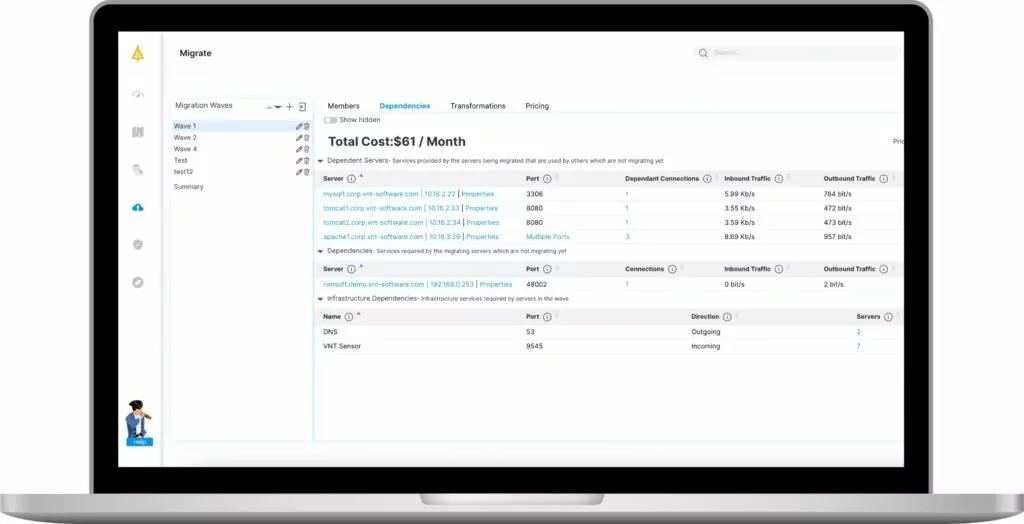
Learn More About Cloud Migration
Cloud Migration Strategy: Planning for Success
Cloud migration comes with challenges, but sound strategy and planning will help overcome these obstacles in order to reap the benefits.
Read more: Cloud Migration Strategy: Planning for Success
A Cloud Migration Checklist to Get Started Successfully
Those who might move to the cloud must start with full visibility of their applications and dependencies to get it right the first time.
Read more: A Cloud Migration Checklist to Get Started Successfully
Application Migration: Here’s What You Need to Know
Let’s take the complexity out of application migration. Here’s common approaches, and the application migration that they suit.
Read more: Application Migration: Here’s What You Need to Know
Cloud Implementation: 5 Top Best Practices for Cloud Success
Cloud implementation gives your organization an edge. Moving workload from on-premises to cloud is convenient and cost-effective.
Read more: Cloud Implementation: 5 Top Best Practices for Cloud Success
Data Center Migration: What is It?
What Is data center migration? Learn about the benefits, types of migrations, and best practices for migrating to a new data center.
Read more: Data Center Migration: What is It?
Cloud Computing Trends: What to Look Out For
Cloud trends to look out for in 2023: What you need to know about cloud computing, technology adoption, and market trends.
Read more: Cloud Computing Trends: What to Look Out For
Understanding the Ins and Outs of Data Center Migration
Migrating data between locations or applications? Here’s what you need to think about when starting a new data center migration project.
Read more: Understanding the Ins and Outs of Data Center Migration
Hybrid Cloud Solutions & What They Can Offer
Our agentless hybrid cloud dependency tool maps on-prem and cloud infrastructure in real-time, focusing on business applications.
Read more: Hybrid Cloud Solutions & What They Can Offer
How to Create a Data Center Transformation Strategy
Today’s data center has zettabytes of data and thousands of applications. This makes continuous data center evolution the key to innovation.
Read more: How to Create a Data Center Transformation Strategy
See Additional Guides on Key Hybrid Cloud Topics
Together with our content partners, we have authored in-depth guides on several other topics that can also be useful as you explore the world of hybrid cloud.
Nutanix
Authored by Faddom
- [Guide] Nutanix: History, Products, and Top 5 Alternatives
- [Guide] Nutanix vs. VMware: 5 Key Differences and How to Choose
- [Product] Faddom | Instant Application Dependency Mapping Tool
Disaster Recovery
Authored by Faddom
- [Guide] IT Disaster Recovery: What is It?
- [Guide] Disaster Recovery in Azure: A Practical Guide
- [Product] Faddom | Instant Application Dependency Mapping Tool
VMware Storage
Authored by Cloudian

